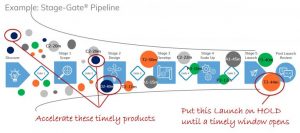Rapid responders are organizations that are already reviewing the innovation pipeline to detect timely opportunity. In response to new environmental factors and circumstances, they pause briefly and ask this of the projects in their pipeline, “is it time…?”
Michelle Jones of Stage-Gate International describes how challenge can spur innovation.
“The middle of difficulty lies an opportunity” – Albert Einstein
Over these past few months, some leaders describe feeling overwhelmed and lacking control as the widening impact of COVID-19 sweeps across the globe.
At the same time, another set of leaders describe a rapid responsiveness – how they are tapping into their innovation pipeline and capability to help their customers in this time of need, and by doing so, are helping themselves. Which lens is your lens?
Rapid responders ask is it ……
Time to Accelerate?
Will our customers/markets benefit to receive this product, service or technology sooner than later, especially under current circumstances?
Time to Hold?
Has the window of opportunity to launch this product, service or technology changed or closed? Should we put this project on hold and assign its resources to a project that should be accelerated?
Time to Kill?
Has the business attractiveness of this product, service or technology deteriorated under the circumstances? Should we stop this project and reassign its resources to a project that should be accelerated?
Time to Go?
Is there a timely idea resume in our idea bank that should be initiated (i.e. moved into Stage 1 to be explored, scoped and shaped), now that resources are available?
Time to Ideate?
Have recent external circumstances created new opportunities for product, service or technology innovations? Should we be responsive to this opportunity by ideating around a new theme?
Reviewing the innovation pipeline
Numerous companies have already made changes to their innovation pipelines in response to the impacts (both positive and negative) of COVID-19 in their business markets.
If you have to form a project team to inventory and classify all of your projects, gather project data, guesstimate business value and timeline durations, assess risk and round up project leaders to obtain a quick status check on their projects, you are most certainly not prepared to respond quickly to opportunities that present. If you lack visibility, you are disadvantaged.
How does an organization learn to recognize and respond to opportunity amidst a changing environment or climate?
Ironically, in order to move flexibly and quickly, you need some structure. Many of the rapid responders have leveraged a structured best practice called a Stage-Gate Pipeline Review to afford them the agility to make quality Go/Kill project investment decisions quickly.
As soon as external conditions begin to change, business leaders examine their Stage-Gate Pipeline for opportunity. Most get into the habit of viewing it on a regular basis. It affords them visibility to all projects underway, namely, each project’s Stage in development lifecycle, market(s) it will serve, business potential (size of prize), strategic rationale, risk index, technical feasibility and approximate cost to complete the project in its current scope.
This contrasts with the more traditional approach of ‘approving’ a list of projects to undertake at the beginning of each budget year. Where the incentive is to finish every project that starts regardless of any change in its ability to deliver value, thus creating a ‘tunnel’. There is no incentive to be on the lookout for or to be responsive to new opportunities that present mid-year as there is no reward for stopping existing projects and no mechanism to free up and reallocate resources.
With Stage-Gate there is no need for lengthy meetings to discuss the detail of every project or endure long debates to get all of the functional leaders ‘on board’.
Because each project has passed through the due diligence of each Gate, the integrity of the project’s placement and priority in the pipeline is reliable. This is crucial as it gives business leaders that are not as familiar with every project’s details the confidence to be responsive by re-prioritizing to new market needs.
Additionally, the Gatekeepers are the cross-functional leaders of the resources needed to execute the project and so with each GO decision, the project is building the necessary alignment and buy-in across the functions. This is a critical enabler of speed.
When innovations are managed using a Stage-Gate Framework, they earn their way through the development lifecycle incrementally, one Stage at a time. This creates a dynamic ‘funnel’ – a pipeline of evolving innovations competing for scarce resources – winners are accelerated and losers are killed.

The dynamic nature of this pipeline affords the greatest flexibility in real time decision-making and surfaces the best opportunities.
More about Stage-Gate and agile from Gary Cooper.
To find out more about Stage-Gate contact Michelle Jones

